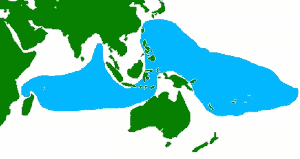 SKC Films Library SKC Films Library |
| SKC Films Library >> Science >> Zoology >> Crustaceans > Subclass Decapoda |
| Coconut Crab Birgus latro Description The largest known terrestrial arthropod, the coconut crab can reach a leg span of 3.3 feet, a body length of 1.3 feet, and a weight of 6.5 pounds; males are significantly larger than females. Like all decapods, the coconut crab has 10 legs. The front-most pair of legs has large claws that are so powerful they can lift objects weighing up to 60 pounds. The next two pairs are large, powerful walking legs with pointed tips, which allow coconut crabs to climb vertical or overhanging surfaces. The fourth pair of legs is smaller with tweezer-like claws at the end, allowing young coconut crabs to grip the inside of a shell or coconut husk to carry for protection; adults use this pair for walking and climbing. The last pair of legs is very small and is used by females to tend their eggs and by the males in mating. This last pair of legs is usually held inside the carapace, in the cavity containing the breathing organs. Body color ranges from purplish-red to orange-red. Distribution and Habitat Coconut crabs are found on oceanic islands and small offshore islets adjacent to large continental islands across the Indo-Pacific region, from Zanzibar in the Indian Ocean to Pitcairn and Easter islands in the Pacific. Christmas Island in the Indian Ocean has the largest and densest population of coconut crabs in the world. Significant populations also live in the Seychelles and the Chagos Archipelago, as well as on several of the Andaman and Nicobar islands in the Bay of Bengal. Although widespread across the western Pacific, the coconut crab is not abundant on most of the islands it inhabits. The largest Pacific population of coconut crabs is found in the Cook Islands.
Coconut crabs live almost exclusively on land, returning to the sea only to release their eggs. They spend their days in burrows dug into sand or loose soil. Coconut crabs are so well adapted to living on land that they will actually drown in sea water in less than a day. The crab does require some contact with the sea, however, as it often drinks the water to maintain its salt balance and females need to return to sea to release eggs, so it is rarely found more than about 3.5 miles from the sea. Lifestyle Although it is entirely terrestrial as an adult, the coconut crab breathes through modified gills. Those gills are surrounded by spongy tissues which must be kept moist, a task the crab accomplishes by dipping its legs into water and passing them over the gills. By day the coconut crab inhabits burrows where it is protected from desiccation and intruders, and by night it goes in search of food. As its name suggests, this crab feeds on coconuts, and is actually able to climb coconut palms up to heights of 20 feet, where it is thought to pinch off coconuts with its powerful claws when coconuts are not already available on the ground. If the coconut does not break open on its fall, the crab husks it by pulling back the husk from the end that was formerly attached to the palm, piercing the "soft eye" with a pointed walking leg, and then gradually enlarging the hole by breaking off sections of the shell until it can reach in to scoop out the flesh. Coconuts are only a small part of this crab's diet, however, as it will feed on almost any fruit available, as well as leaves and other plant parts, turtle eggs and hatchlings, carrion, moulted exoskeletons, and even rats and other small rodents.
Mating occurs on land and the female carries the fertilized eggs beneath her abdomen, held in place by three specialised appendages. When the eggs are ready for hatching, the female walks down to the edge of the sea during high tide and releases the larvae, which remain floating in the sea for up to 28 days while they develop. This is followed by an amphibious stage of 21 to 28 days during which the young crabs occupy gastropod shells and are able to migrate on to the land. The exoskeleton begins to harden at 2-3 years, at which time the juvenile coconut crab can abandon its "mobile home." Moulting occurs in the safety of a burrow and takes around 30 days, after which the crab eats the cast-off exoskeleton. It takes about five years for a coconut crab to reach sexual maturity, and 40-60 years for it to reach its maximum size. Scientific Classification phylum Arthropoda |
| SKC Films Library >> Science >> Zoology >> Crustaceans > Subclass
Decapoda This page was last updated on June 11, 2017. |

